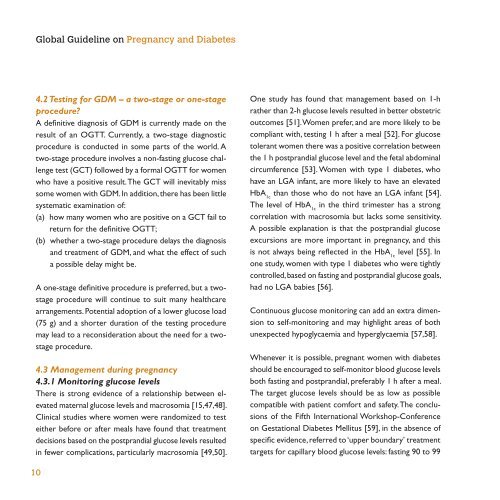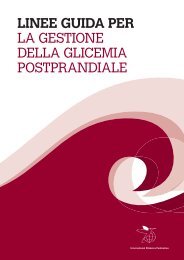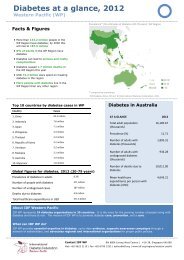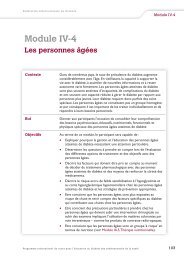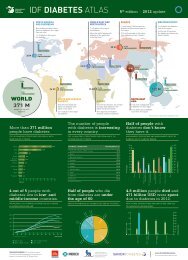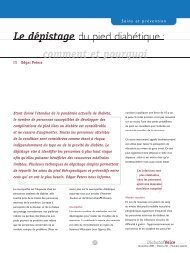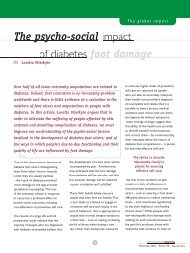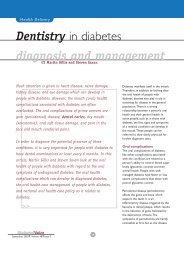Global guideline on pregnancy and diabetes - International ...
Global guideline on pregnancy and diabetes - International ...
Global guideline on pregnancy and diabetes - International ...
Create successful ePaper yourself
Turn your PDF publications into a flip-book with our unique Google optimized e-Paper software.
<str<strong>on</strong>g>Global</str<strong>on</strong>g> Guideline <strong>on</strong> Pregnancy <strong>and</strong> Diabetes<br />
4.2 Testing for GDM – a two-stage or <strong>on</strong>e-stage<br />
procedure?<br />
A definitive diagnosis of GDM is currently made <strong>on</strong> the<br />
result of an OGTT. Currently, a two-stage diagnostic<br />
procedure is c<strong>on</strong>ducted in some parts of the world. A<br />
two-stage procedure involves a n<strong>on</strong>-fasting glucose challenge<br />
test (GCT) followed by a formal OGTT for women<br />
who have a positive result. The GCT will inevitably miss<br />
some women with GDM. In additi<strong>on</strong>, there has been little<br />
systematic examinati<strong>on</strong> of:<br />
(a) how many women who are positive <strong>on</strong> a GCT fail to<br />
return for the definitive OGTT;<br />
(b) whether a two-stage procedure delays the diagnosis<br />
<strong>and</strong> treatment of GDM, <strong>and</strong> what the effect of such<br />
a possible delay might be.<br />
A <strong>on</strong>e-stage definitive procedure is preferred, but a twostage<br />
procedure will c<strong>on</strong>tinue to suit many healthcare<br />
arrangements. Potential adopti<strong>on</strong> of a lower glucose load<br />
(75 g) <strong>and</strong> a shorter durati<strong>on</strong> of the testing procedure<br />
may lead to a rec<strong>on</strong>siderati<strong>on</strong> about the need for a twostage<br />
procedure.<br />
4.3 Management during <strong>pregnancy</strong><br />
4.3.1 M<strong>on</strong>itoring glucose levels<br />
There is str<strong>on</strong>g evidence of a relati<strong>on</strong>ship between elevated<br />
maternal glucose levels <strong>and</strong> macrosomia [15,47,48].<br />
Clinical studies where women were r<strong>and</strong>omized to test<br />
either before or after meals have found that treatment<br />
decisi<strong>on</strong>s based <strong>on</strong> the postpr<strong>and</strong>ial glucose levels resulted<br />
in fewer complicati<strong>on</strong>s, particularly macrosomia [49,50].<br />
One study has found that management based <strong>on</strong> 1-h<br />
rather than 2-h glucose levels resulted in better obstetric<br />
outcomes [51]. Women prefer, <strong>and</strong> are more likely to be<br />
compliant with, testing 1 h after a meal [52]. For glucose<br />
tolerant women there was a positive correlati<strong>on</strong> between<br />
the 1 h postpr<strong>and</strong>ial glucose level <strong>and</strong> the fetal abdominal<br />
circumference [53]. Women with type 1 <strong>diabetes</strong>, who<br />
have an LGA infant, are more likely to have an elevated<br />
HbA 1c<br />
than those who do not have an LGA infant [54].<br />
The level of HbA 1c<br />
in the third trimester has a str<strong>on</strong>g<br />
correlati<strong>on</strong> with macrosomia but lacks some sensitivity.<br />
A possible explanati<strong>on</strong> is that the postpr<strong>and</strong>ial glucose<br />
excursi<strong>on</strong>s are more important in <strong>pregnancy</strong>, <strong>and</strong> this<br />
is not always being reflected in the HbA 1c<br />
level [55]. In<br />
<strong>on</strong>e study, women with type 1 <strong>diabetes</strong> who were tightly<br />
c<strong>on</strong>trolled, based <strong>on</strong> fasting <strong>and</strong> postpr<strong>and</strong>ial glucose goals,<br />
had no LGA babies [56].<br />
C<strong>on</strong>tinuous glucose m<strong>on</strong>itoring can add an extra dimensi<strong>on</strong><br />
to self-m<strong>on</strong>itoring <strong>and</strong> may highlight areas of both<br />
unexpected hypoglycaemia <strong>and</strong> hyperglycaemia [57,58].<br />
Whenever it is possible, pregnant women with <strong>diabetes</strong><br />
should be encouraged to self-m<strong>on</strong>itor blood glucose levels<br />
both fasting <strong>and</strong> postpr<strong>and</strong>ial, preferably 1 h after a meal.<br />
The target glucose levels should be as low as possible<br />
compatible with patient comfort <strong>and</strong> safety. The c<strong>on</strong>clusi<strong>on</strong>s<br />
of the Fifth Internati<strong>on</strong>al Workshop-C<strong>on</strong>ference<br />
<strong>on</strong> Gestati<strong>on</strong>al Diabetes Mellitus [59], in the absence of<br />
specific evidence, referred to ‘upper boundary’ treatment<br />
targets for capillary blood glucose levels: fasting 90 to 99<br />
10<br />
Pregnancy_EN2.indd 10 16/09/09 15:42


